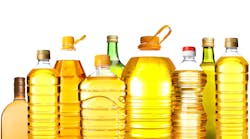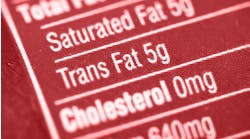The marriage between "healthy" and "fat" is a rare coupling. However, food processors recognize that delicious consumer products would only be possible with the structure and flavor of fat and oil.
Oils and fats provide the framework for baked goods, sauces, ice cream and other processed foods. Additionally, they augment the texture and flavor of countless numbers of dishes.
To reconcile the necessity of fats and oils in processed foods with the powerful consumer desire for healthier fare, fat and oil suppliers are dedicated to developing products that meet both needs. After all, the body needs fat to survive.
“The body needs fatty acids (FA) or fats to create healthy cell membranes, nerves, hormones, body tissues and to store energy," says chef and nutritionist Lindsey Davis. "Fats allow our bodies to absorb fat-soluble vitamins such as A, D, E and K. Fat also provides energy at 9kcal/g.
“All dietary fat and oils are a mixture of FA packaged as triglycerides,” she continues. “However, some foods have a higher proportion of a certain type of FA. There are four categories: polyunsaturated fatty acids (PUFAs), monounsaturated fatty acids (MUFAs), saturated fatty acids (SFAs) and artificial trans-fats, partially hydrogenated fats or oils. This last category is purely manufactured and not found in nature," Davis says.
And they’re no longer allowed to be added to food products, although they do occur naturally in some.
Trans fats, created by adding hydrogen to vegetable oil, such as partially hydrogenated oil, were exceptional at performing many functions in many applications. In addition, they were simple to use, inexpensive and possessed numerous desirable properties. However, their negative impact on serum cholesterol led to their downfall.
As a result, the FDA removed them from the list of generally recognized as safe (GRAS) ingredients in 2015, banned their use in most food applications in mid-2018, and initiated a total ban on their use in 2020.
The prohibition of trans fat led many manufacturers to revert to saturated fat. Saturated fats are fat molecules that lack double bonds between their carbon atoms. Similar to trans fats, saturated fats are typically solid at room temperature. As a result, they are frequently employed in desserts, processed meats and dairy products.
However, health-conscious consumers are skeptical of saturated fat. This has been the case for years because of its association with an individual's LDL cholesterol. Although recent studies have indicated that some saturated fats may have health benefits, this type of fat is still generally considered unhealthy.
Oleic acid makes it healthy
While the FDA restricted the amount of trans fats that could be in food, the agency approved a qualified claim for cardiovascular health in edible oils that contained high levels of oleic acid. Oleic acid is a monounsaturated fat that has been demonstrated to have cardio-protective properties when it replaces harmful saturated fat.
Oils must have at least 70% oleic acid to qualify for heart-healthy claims. Oils meeting this claim include: high-oleic sunflower oil, high-oleic safflower oil, high-oleic canola oil, olive oil and high-oleic algal oil.
Initially, these oils were primarily used in liquid applications, such as frying and spray oils but have since been incorporated into solid fat applications that require additional structuring or processing to provide the necessary functional or textural properties.
Cargill's Clear Valley All-Purpose Shortening combines high-oleic canola and hydrogenated cottonseed oils. This shortening has 23% saturated fat, compared to 50% in palm shortening. Additionally, Clear Valley All Purpose Shortening still fulfills its role of being malleable, tasting pleasant and straightforward in bakery operations. These are all important factors to customers who bake bread.
Other times, the fat and oil supplier can combine different fats and oils into a new product that meets the processor's requirements. In some cases, the fat and oil supplier will address a request from a manufacturer by utilizing a multi-ingredient system innovation. This enables processors to use other ingredients to provide an essential function traditionally associated with fat.
For instance, protein and fiber can contribute to emulsification and bulk addition, respectively. And these ingredients also contribute positively to the nutritional value of the final product.
Foods that utilize common oils often require additional additives to preserve them because of the high concentration of polyunsaturated fatty acids, which leads to decomposition over time. However, because of their unique composition, high-oleic oils are more likely to be stable under oxidative conditions than commodity oils.
Sunflower oil comes in mid-oleic and high-oleic formats; however, the demand for high-oleic sunflower oil is growing, due to its superior stability and longer shelf life, compared to other oils.
In addition to being low in saturated fat, sunflower oil is also low in linoleic acid, an omega-6 fatty acid that lacks stability and longevity and can impart a bitter taste. Also, sunflower oil has the highest concentration of vitamin E of any oil.
Sunflower oil is a premium fry oil in foodservice and manufacturing settings due to its high smoke point (450F) and monounsaturated fat content. Along with its neutral flavor and long shelf life, sunflower oil positively affects the mouthfeel, texture and taste of plant-based foods, among other food stuffs.
Sunflower oil is a good choice for savory snacks like chips since it has a high heat point and long fry life. In addition, using sunflower oil in crackers adds lubricity and a moisture barrier that helps prevent staling. For granola and protein snack bars, sunflower oil contains antioxidants that help stabilize ingredients such as grains, seeds and nuts.
Other practical applications include sauces, salad dressings, sweet or savory dips and spreads since it provides consistent consumer-pleasing texture and viscosity. The inherent stability of sunflower oil and its ability to support clean and clear labels make it an excellent solution for these applications.
Sunflower oil is often used to help to reduce and replace saturated fat in bakery products. Sun oil blends well with other fats and oils and performs well in artisan bread, muffins and sweet bread.
Soybean oil with a high oleic acid content was not originally on the FDA's list of oils that can utilize the heart-health claim, in large part because there were not enough high-oleic soybeans to pursue the claim.
But the soybean industry began building a supply of high-oleic soybean oil. The soybean industry is committed to producing 9 billion pounds of U.S.-grown soybeans high in oleic acid by 2027. As a result, high-oleic soybeans are expected to have a larger share of the fourth-largest class of crops by 2024.
Other healthy aspects side of oils
While fats and oils are often considered unhealthy ingredients, some provide essential benefits for health. Food processors that want to increase the overall healthiness of their products will sometimes do this by altering the oil they use.
The fatty acid compositions of different oils have different health benefits, some of which contribute to the health of the heart, brain and eyes, as well as decreasing cholesterol and reducing inflammation in the body.
Oils containing omega-3 and 6 are considered polyunsaturated essential fatty acids, which the body cannot produce independently. So, it's necessary to incorporate them, in addition to omega-9, into the diet.
Omega-3 is derived from fish oil, flax oil and walnut oil. Omega-6 is found in borage, black currant, black cumin and evening primrose. Omega-9 comes from avocado, canola, olive and sunflower oils.
Many oils comprise a mixture of omegas, but there are notably higher omega-3 and 6 percentages in chia seed oil and hempseed oil; omega-3, 6 and 9 in sacha inchi; and omega-2, 6, 7 and 9 in sea buckthorn.


